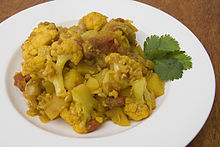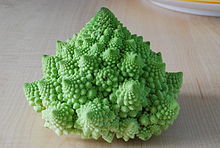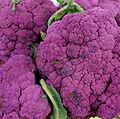- Cauliflower
-
Cauliflower
Cauliflower, cultivar unknownDetails Species Brassica oleracea Cultivar group Botrytis cultivar group Origin Northeast Mediterranean Cultivar group members Many; see text. For other uses, see Cauliflower (disambiguation).Cauliflower is one of several vegetables in the species Brassica oleracea, in the family Brassicaceae. It is an annual plant that reproduces by seed. Typically, only the head (the white curd) of aborted floral meristems is eaten, while the stalk and surrounding thick, green leaves are used in vegetable broth or discarded.
Its name is from Latin caulis (cabbage) and flower,[1] an acknowledgment of its unusual place among a family of food plants which normally produces only leafy greens for eating. Brassica oleracea also includes cabbage, brussels sprouts, kale, broccoli, and collard greens, though they are of different cultivar groups.
For such a highly modified plant, cauliflower has a long history. François Pierre La Varenne employed chouxfleurs in Le cuisinier françois.[2] They had been introduced to France from Genoa in the 16th century, and are featured in Olivier de Serres' Théâtre de l'agriculture (1600), as cauli-fiori "as the Italians call it, which are still rather rare in France; they hold an honorable place in the garden because of their delicacy",[3] but they did not commonly appear on grand tables until the time of Louis XIV.[4]
Contents
Classification and identification
Botanical varieties
Cauliflower and broccoli are the same species and have very similar structures, though cauliflower replaces the green flower buds with a white inflorescence meristem.
Major groups
There are four major groups of cauliflower.[5]
- Italian
- Diverse in appearance, and biennial and annual in type, this group includes white, Romanesco, various green, purple, brown and yellow cultivars. This type is the ancestral form from which the others were derived.
- Northwest European biennial
- Used in Europe for winter and early spring harvest, this was developed in France in the 19th century, and includes the old cultivars Roscoff and Angers.
- Northern European annuals
- Used in Europe and North America for summer and fall harvest, it was developed in Germany in the 18th century, and includes old cultivars Erfurt and Snowball.
- Asian
- A tropical cauliflower used in China and India, it was developed in India during the 19th century from the now-abandoned Cornish type,[6] and includes old varieties Early Patna and Early Benaras.
Varieties
A comprehensive list of varieties is maintained at North Carolina State University.[7] Traditional varieties include 'Snowball', 'Hybrid White', 'Super Snowball', 'Snow Crown', 'Mayflower', Candid Charm', 'Mormon', 'Agrahani', 'poushi', 'maghi', 'Snow White' and 'Snow Grace'.
Self-blanching varieties are 'Self Blanche', 'Early Tuscan' and 'Late Tuscan'.
Heirloom varieties include 'All the Year Round', 'Early Pearl', 'Early Snowball', 'Igloo', 'Violetta Italia' and 'Walcheren Winter'.
Commercial varieties include 'Fremont', 'Igloo' and 'Snow Crown'
Colors
- White
- White cauliflower is the most common colour of cauliflower.
- Orange
- Orange cauliflower (B. oleracea L. var. botrytis) contains 25 times the level of vitamin A of white varieties. This trait came from a natural mutant found in a cauliflower field in Canada.[8] Cultivars include 'Cheddar' and 'Orange Bouquet'.
- Green
- Green cauliflower, of the B. oleracea botrytis group, is sometimes called broccoflower. It is available both with the normal curd shape and a variant spiky curd called Romanesco broccoli. Both types have been commercially available in the U.S. and Europe since the early 1990s. Green-curded varieties include 'Alverda', 'Green Goddess' and 'Vorda'. Romanesco varieties include 'Minaret' and 'Veronica'.
- Purple
- Purple color in cauliflower is caused by the presence of the antioxidant group anthocyanins, which can also be found in red cabbage and red wine.[9] Varieties include 'Graffiti' and 'Purple Cape'. In Great Britain and southern Italy, a broccoli with tiny flower buds is sold as a vegetable under the name "purple cauliflower". It is not the same as standard cauliflower with a purple curd.
Nutrition
Cauliflower, raw (edible parts) Nutritional value per 100 g (3.5 oz) Energy 103 kJ (25 kcal) Carbohydrates 5 g - Sugars 1.9 g - Dietary fiber 2 g Fat 0.3 g Protein 2 g Water 92 g Thiamine (vit. B1) 0.05 mg (4%) Riboflavin (vit. B2) 0.06 mg (5%) Niacin (vit. B3) 0.507 mg (3%) Pantothenic acid (B5) 0.667 mg (13%) Vitamin B6 0.184 mg (14%) Folate (vit. B9) 57 μg (14%) Vitamin C 48 mg (58%) Vitamin K 15.5 μg (15%) Calcium 22 mg (2%) Iron 0.42 mg (3%) Magnesium 15 mg (4%) Phosphorus 44 mg (6%) Potassium 299 mg (6%) Sodium 30 mg (2%) Zinc 0.27 mg (3%) Percentages are relative to US recommendations for adults.
Source: USDA Nutrient DatabaseCauliflower is low in fat, low in carbs but high in dietary fiber, folate, water, and vitamin C, possessing a high nutritional density.[citation needed]
Cauliflower contains several phytochemicals, common in the cabbage family, that may be beneficial to human health.
- Sulforaphane, a compound released when cauliflower is chopped or chewed, may protect against cancer.
- Other glucosinolates
- Carotenoids[10]
- Indole-3-carbinol, a chemical that enhances DNA repair,[11][12] and acts as an estrogen antagonist,[13] slowing the growth of cancer cells.
Boiling reduces the levels of these compounds, with losses of 20–30% after five minutes, 40–50% after ten minutes, and 75% after thirty minutes.[14] However, other preparation methods, such as steaming, microwaving, and stir frying, had no significant effect on the compounds.[14]
A high intake of cauliflower has been associated with reduced risk of aggressive prostate cancer.[15]
100g of cauliflower contains the following nutritional information according to the USDA:
- Calories : 25
- Fat: 0.28
- Carbohydrates: 4.97
- Fibers: 2
- Protein: 1.92
Cooking
Cauliflower can be roasted, boiled, fried, steamed or eaten raw. Steaming or microwaving better preserves anticancer compounds than boiling.[14] When cooking, the outer leaves and thick stalks are removed, leaving only the florets. The leaves are also edible, but are most often discarded.[16] The florets should be broken into similar-sized pieces so they are cooked evenly. After eight minutes of steaming, or five minutes of boiling, the florets should be soft, but not mushy (depending on size). Stirring while cooking can break the florets into smaller, uneven pieces. Cauliflower is often served with a cheese sauce, as in the dish cauliflower cheese.
Low carbohydrate dieters can use cauliflower as a reasonable substitute for potatoes; while they can produce a similar texture, or mouth feel, they lack the starch of potatoes.
Fractal dimension
Cauliflower has been noticed by mathematicians for its distinct fractal dimension,[17][18] predicted to be about 2.8.[19]
History
The first reliable reference to cauliflower is found in the writings of the Arab Muslim scientists Ibn al-'Awwam and Ibn al-Baitar, which date from the 12th and 13th centuries.[20]
Gallery
-
Dyed pink Cauliflower in Nablus
References
Footnotes
- ^ "Cauliflower: definition". dictionary.com. 2006. http://dictionary.reference.com/browse/cauliflower. Retrieved 2008-11-22.
- ^ Barbara Ketcham Wheaton, Savoring the Past: the French kitchen and table from 1300 to 1789 1996:118.
- ^ Wheaton 1996:66.
- ^ Maguelonne Toussaint-Samat, A History of Food, 2nd ed. 2009:625f.
- ^ Crisp, P. (1982). "The use of an evolutionary scheme for cauliflowers in screening of genetic resources". Euphytica 31 (3): 725. doi:10.1007/BF00039211.
- ^ Swarup, V. and Chatterjee, S.S (1972). "Origin and genetic improvement of Indian cauliflower". Economic Botany 26 (4): 381–393. doi:10.1007/BF02860710.
- ^ Farnham, M. (2007). "Vegetable Cultivar Descriptions for North America:Cauliflower". http://cuke.hort.ncsu.edu/cucurbit/wehner/vegcult/cauliflower.html. Retrieved 2007-09-19.
- ^ Dickson, M.H., Lee C.Y., Blamble A.E. (1988). "Orange-curd high carotene cauliflower inbreds, NY 156, NY 163, and NY 165". HortScience 23: 778–779.
- ^ "Anthocyanin in Cauliflower". http://www.ars.usda.gov/research/publications/publications.htm?SEQ_NO_115=179842.
- ^ "Breeding Better Broccoli: Research Points To Pumped Up Lutein Levels In Broccoli". Science Daily. 8 November 2009. http://www.sciencedaily.com/releases/2009/11/091104132824.htm. Retrieved 5 September 2010.
- ^ "Broccoli chemical's cancer check". BBC News. 7 February 2006. http://news.bbc.co.uk/2/hi/health/4688854.stm. Retrieved 5 September 2010.
- ^ "How Dietary Supplement May Block Cancer Cells". Science Daily. 30 June 2010. http://www.sciencedaily.com/releases/2010/06/100629131316.htm. Retrieved 5 September 2010.
- ^ Carcinogens at Oxford Journal. Retrieved December 14, 2006
- ^ a b c Warwick Medical School, University of Warwick (2007-05-15). "Research Says Boiling Broccoli Ruins Its Anti Cancer Properties.". http://www2.warwick.ac.uk/newsandevents/pressreleases/research_says_boiling/.
- ^ Kirsh, VA; Peters U, Mayne ST, Subar AF, Chatterjee N, Johnson CC, Hayes RB (2007). "Prospective study of fruit and vegetable intake and risk of prostate cancer". Journal of the National Cancer Institute 99 (15): 1200–9. doi:10.1093/jnci/djm065. PMID 17652276.
- ^ Stephens, MJ (1998). "Secondary Edible Parts of Vegetables". Vegetarian 5. http://extension-horticulture.tamu.edu/extension/newsletters/vpmnews/apr02/art4apr.html.
- ^ Fractal Food
- ^ Description of the Julia sets of the cabbage fractal
- ^ "Fractal Structure of a White Cauliflower". Journal of Korean physical society 46 (2): 474–477. http://icpr.snu.ac.kr/resource/wop.pdf/J01/2005/046/R02/J012005046R020474.pdf. Retrieved 2008-06-05.
- ^ Fenwick, G. Roger; Heaney, Robert K., Mullin, W. John, VanEtten, Cecil H. (1 January 1982). "Glucosinolates and their breakdown products in food and food plants". C R C Critical Reviews in Food Science and Nutrition 18 (2): 123–201. doi:10.1080/10408398209527361.
Sources
- Sharma, S.R, Singh, P.K., Chable, V. Tripathi, S.K. (2004). "A review of hybrid cauliflower development". Journal of New Seeds 6 (2–3): 151. doi:10.1300/J153v06n02_08.
External links
- PROTAbase on Brassica oleracea (cauliflower and broccoli)
- Fractal dimensions of a green broccoli and a white cauliflower (Kim) (PDF)
- Cultural information on cauliflower
- Orange Cauliflower Development
- Cabbages and Cauliflowers: How to Grow Them by James John Howard Gregory
- Cauliflower nutritional information
Categories:- Inflorescence vegetables
- Brassica oleracea
- Cultivars
- Edible plants
Wikimedia Foundation. 2010.







